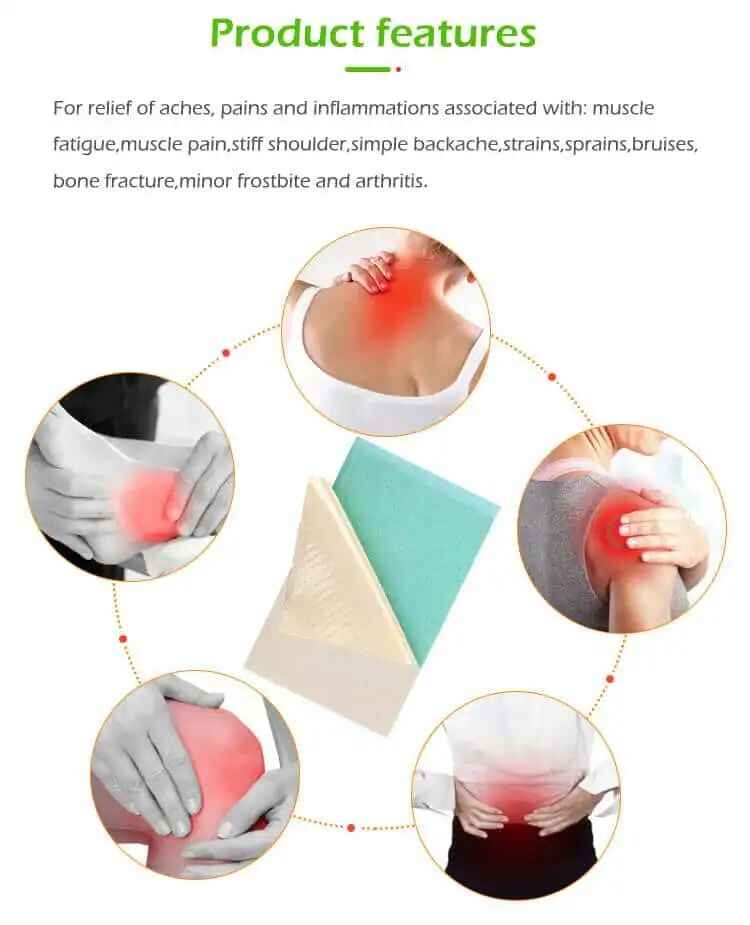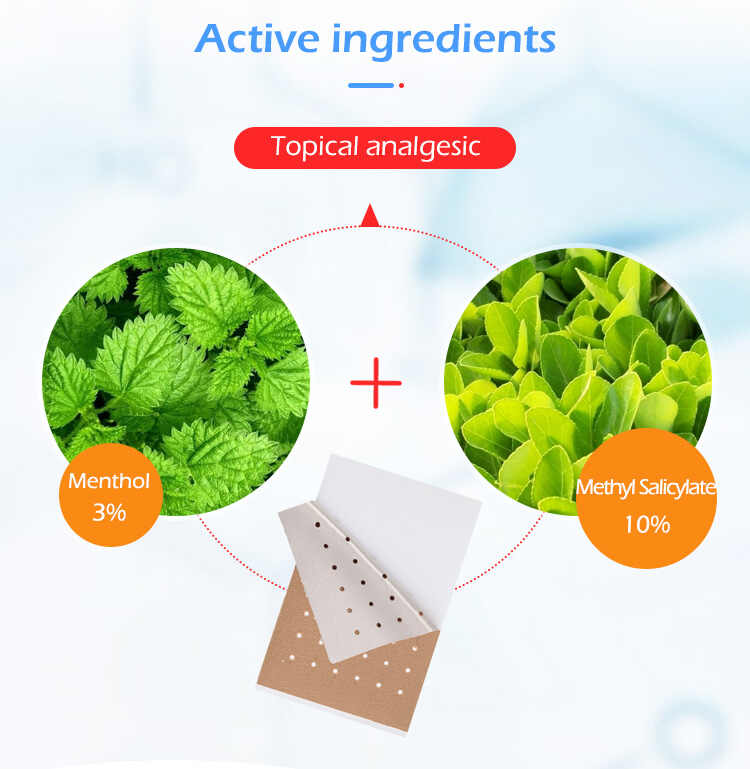What Ingredients Are Commonly Used in Chronic Pain Patches?
As demand for convenient and effective pain relief solutions grows globally, Chronic Pain Patches have become an increasingly popular product category. Whether you're a brand looking to develop your own line or a consumer seeking to understand what goes into these products, it's essential to know which ingredients are most commonly used. This article provides an in-depth exploration of the key ingredients found in Chronic Pain Patches, their purposes, and what to consider when working with a Chronic Pain Patches Manufacturer, Chronic Pain Patches OEM, or Chronic Pain Patches Supplier.

Understanding Chronic Pain Patches and Their Mechanism
Chronic Pain Patches are transdermal delivery systems designed to release active ingredients through the skin to relieve long-term pain conditions, such as arthritis, back pain, muscle soreness, or neuropathic pain. Unlike oral medications, these patches offer localized relief with fewer systemic side effects. A Custom Chronic Pain Patches formula, developed in collaboration with a qualified Chronic Pain Patches OEM, can be tailored to address specific pain types or customer preferences.
1. Commonly Used Active Ingredients in Chronic Pain Patches
1.1 Menthol
Menthol is one of the most frequently used ingredients in Chronic Pain Patches. It provides a cooling sensation and temporarily relieves minor pain by desensitizing nerve endings.
Function: Analgesic, cooling agent
Concentration Range: 1%–10%
Why it’s popular: Immediate soothing effect and consumer recognition
1.2 Methyl Salicylate
Methyl salicylate, commonly known as wintergreen oil, is another popular ingredient. It acts as a counterirritant, producing a warming sensation that distracts from deeper pain.
Function: Topical analgesic
Concentration Range: 10%–30%
Synergy: Often combined with menthol in Custom Chronic Pain Patches
1.3 Capsaicin
Derived from chili peppers, capsaicin reduces the amount of substance P—a neurotransmitter involved in pain transmission—thus relieving pain over time.
Function: Long-term nerve desensitizer
Ideal For: Arthritis, nerve pain
Note: Requires careful dosing and professional guidance from a Chronic Pain Patches Manufacturer
1.4 Lidocaine
Lidocaine is a well-known anesthetic that numbs the skin and underlying tissues. It is ideal for localized nerve-related pain.
Function: Numbing agent
Typical Use: 4% in OTC patches
Popular in: Private Label Chronic Pain Patches in North America
2. Herbal and Natural Ingredients Gaining Popularity
Brands increasingly collaborate with Chronic Pain Patches OEM providers to develop herbal or all-natural alternatives. These are ideal for markets with strong preferences for holistic or clean-label products.
2.1 Camphor
Function: Counterirritant with warming effect
Natural Source: Camphor tree
Common Pairing: Menthol for dual-action pain relief
2.2 Arnica Montana
Function: Anti-inflammatory and bruising support
Ideal For: Sports-related injuries
Demanded In: Natural Private Label Chronic Pain Patches
2.3 Ginger Extract
Function: Circulation booster and anti-inflammatory
Preferred In: Asian markets and clean-label wellness products
2.4 Turmeric (Curcumin)
Function: Anti-inflammatory and antioxidant
Popular In: Custom Chronic Pain Patches focused on long-term relief
3. Carrier and Supportive Ingredients in Pain Patches
While active ingredients drive the effectiveness of Chronic Pain Patches, excipients and carrier materials also play a crucial role. A professional Chronic Pain Patches Manufacturer ensures all components work harmoniously.
3.1 Acrylic Adhesives
Ensure the patch sticks securely to the skin for prolonged periods.
3.2 Hydrogel Matrix
Offers a cooling effect and gentle application; ideal for sensitive skin and herbal patches.
3.3 Permeation Enhancers
Substances like ethanol or oleic acid that improve the absorption of active ingredients through the skin.
4. Considerations When Choosing Ingredients with a Chronic Pain Patches OEM
4.1 Target Audience Needs
Whether you're targeting athletes, elderly consumers, or individuals with chronic conditions, a Custom Chronic Pain Patches formulation should be tailored accordingly.
4.2 Regulatory Compliance
Different countries have specific regulations on ingredient percentages and combinations. An experienced Chronic Pain Patches Supplier will help ensure compliance with FDA, CE, or other international standards.
4.3 Product Claims and Testing
Back up ingredient efficacy with clinical data or third-party testing. This adds credibility to your Private Label Chronic Pain Patches and helps with marketing and retail approvals.
5. Custom Formulations and Private Labeling Opportunities
A Chronic Pain Patches OEM can work with your brand to:
Combine herbal and pharmaceutical ingredients for hybrid solutions.
Create market-specific versions of the same product.
Offer fragrance-free, hypoallergenic, or sensitive-skin-friendly options.
Develop premium Private Label Chronic Pain Patches with branded packaging and marketing support.
This level of customization enhances product appeal and positions your brand as a leader in pain management.
Final Thoughts
Understanding the ingredients in Chronic Pain Patches is vital not only for product effectiveness but also for market success. Whether you're seeking fast relief formulations or natural pain management solutions, the right combination of active and supportive ingredients makes all the difference. Working with an experienced Chronic Pain Patches Manufacturer or Chronic Pain Patches Supplier allows you to develop safe, effective, and innovative solutions tailored to your target audience. From Custom Chronic Pain Patches to Private Label Chronic Pain Patches, ingredient selection is where quality and branding begin.
Related Questions & Answers
1. What is the most effective ingredient in Chronic Pain Patches?
Menthol and lidocaine are widely regarded as effective for short-term relief, while capsaicin works well for chronic nerve pain.
2. Can I create a herbal-only Chronic Pain Patch with a Chronic Pain Patches OEM?
Yes. Many Chronic Pain Patches Manufacturers specialize in herbal and natural ingredient formulations.
3. How can I ensure ingredient safety and compliance?
Choose a Chronic Pain Patches Supplier that follows GMP and FDA/ISO regulations and provides documentation for all ingredients.
4. Are natural ingredients as effective as pharmaceutical ones?
They can be, depending on the formulation and pain type. Herbal patches often suit long-term, low-grade pain and are preferred by holistic consumers.
5. Can I combine multiple active ingredients in one patch?
Yes, but it must be done under strict formulation guidance to ensure safety, efficacy, and regulatory compliance.






